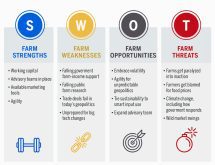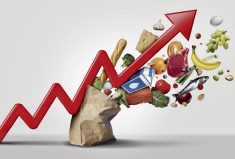When it comes to managing risk to their operations, farmers are well versed in the usual suspects — whether that’s risks in the field like adverse weather, disease and equipment failure, or whether it’s spiking interest rates, lack of adequate cash flow, or being over-leveraged. But one often overlooked risk is when dealing with foreign currencies.
Since agriculture is a largely export-focused industry in Canada, it is susceptible to volatility in exchange rates. Indeed, after cost of production, perhaps the most important cost for farmers to know is that of the dollar and its value against other currencies.
Read Also

Riding the tariff rollercoaster
Farmers are accustomed to roller-coaster years. But the current geopolitical windstorm is something else entirely. On his cattle operation near…
So, do you need a foreign exchange strategy, or can you improve your existing strategy?
- Read more: Four common foreign exchange myths
Assess your risk
It’s not a question of whether you will or will not have risk, but rather what is your risk.
The purpose of a foreign exchange (FX) strategy is not to make money, but to prevent losses. The first step to protecting against the possibility of loss is to identify where your farm has exposure to foreign exchange risk. The most common areas are the prices of agriculture products (since many agricultural commodities are priced in U.S. dollars) and the prices of some inputs. Another area of potential exposure is bound up with capital equipment purchases.
The three Vs
Once you’ve identified the areas of risk, determine how much exposure you have, and what your options are to mitigate or eliminate the risk, or to transfer it to someone else such as a supplier or end-user.
Most Canadian farms and ranches will have exposure to U.S. dollar fluctuations on sales and/or purchases, and it’s important to consider some key questions:
- What are the potential losses or gains if the Canadian dollar rises, or falls, over the next few months, even if it changes by just a few cents?
- What do those potential losses or gains translate to as a percentage of sales and profits?
- Can any losses be passed on through higher prices, or trimmed out of operating costs?
Also, assess the three Vs: the amount of money that is exposed (volume), how quickly the exchange rate may move (velocity) and the impact of potential rate fluctuations (volatility).
Create your FX strategy
While there is no single strategy for managing foreign exchange risk, the most important thing is to take a disciplined approach and apply it consistently. Two common ways of protecting against future rate fluctuations are by hedging forward contracts or via options.
On the other hand, some producers may choose to “go naked” and remain exposed to fluctuation risks. This can be a strategy in and of itself, and sometimes it can work in their favour. But given that no one can forecast the market, can you afford the risk of exposure?
One recommendation is to lock in your FX strategy at the same time as your selling price on the sale of commodities to manage foreign fluctuations and price risk. Whatever your approach, your objectives will depend on the following factors:
- The impact foreign exchange exposure has on your operation.
- Which currencies you’re trading in.
- Your risk tolerance and attitude towards the business.
- Your level of knowledge and comfort with financial markets and instruments.
- How much control you have over the farm’s financial management.
Once you’ve determined your objectives for managing foreign exchange risk, be sure to draft a written document that you can add to your overall business plan.
With objectives in place, it’s time to implement your strategy. A foreign exchange specialist can help you decide which vehicles to use, including spot transactions, forward contracts and foreign exchange options. Find out the costs and determine which solutions are best suited to meet your goals of risk reduction.
As with your overall business plan and budget, your FX plan is of no use if it’s not producing the desired results. Make sure you review and track the performance of every vehicle. What is the result, and how does that compare with the result if you had not used that vehicle?
The information you gather will help decide if your current strategy is working to protect you against risk, and whether the savings justify the cost.
Gwen Paddock, senior director, agriculture at RBC is a specialist in agribusiness. Since earning her B.Sc. with a major in agriculture economics she has been working with agriculture clients. A farmer at heart, Paddock was raised on a beef cow-calf farm outside Guelph, Ont., and participated in 4-H and Junior Farmers. To find out more visit www.rbcroyalbank.com/commercial/agriculture.















